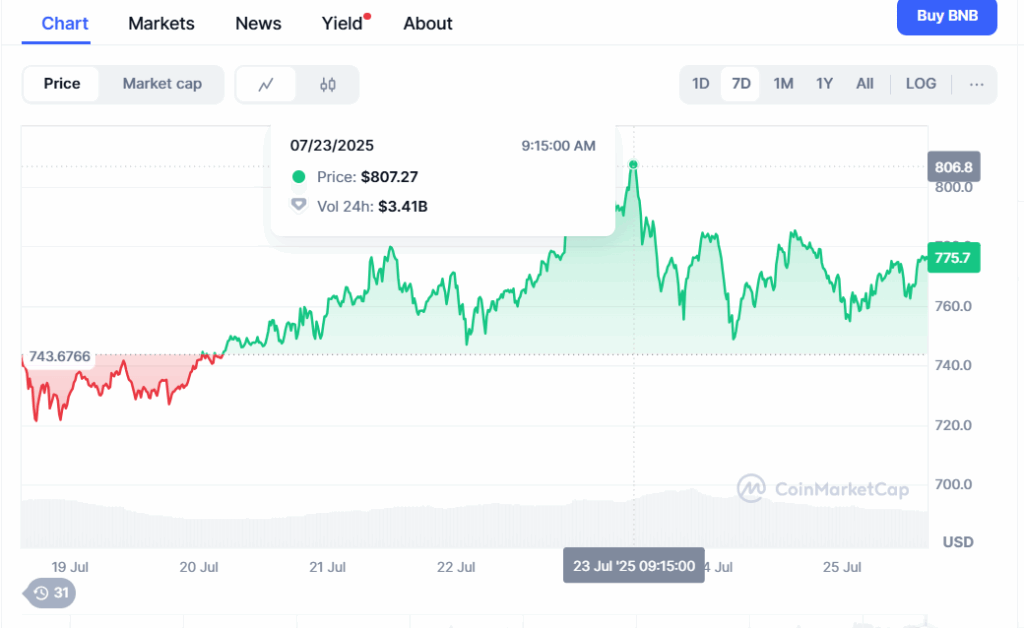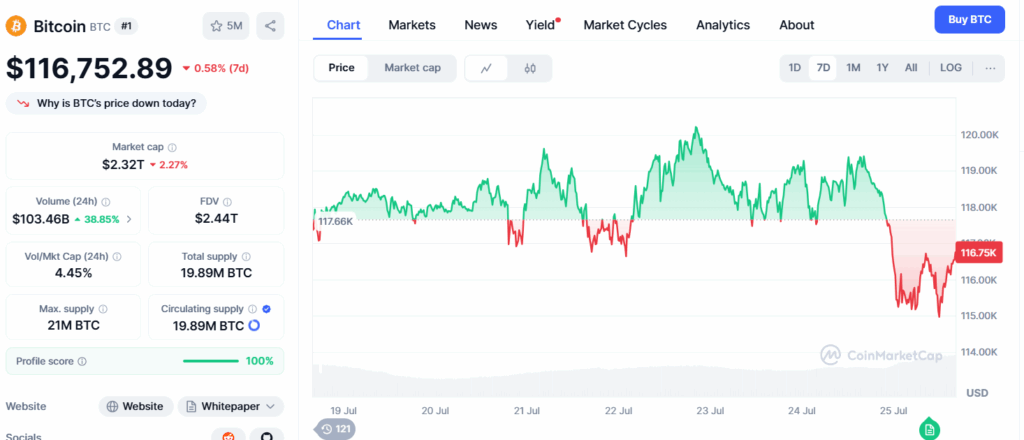
In recent days, a wave of key developments has reshaped the global crypto market: record institutional inflows, regulatory progress in the U.S., new strategies from major banks, and the rise of Ethereum as the leading asset in ETF capital inflows.
In just one week, over $4.39 billion was invested in regulated crypto products. For the first time in 2025, Ethereum surpassed Bitcoin in institutional inflows — a clear signal of shifting investor preferences.
Meanwhile, the U.S. Congress approved the CLARITY Act, JPMorgan began testing crypto-backed loans using BTC and ETH as collateral, and BlackRock’s ETHA ETF reached $10 billion in AUM in record time.
But not everything was positive: deepfake scams, billion-dollar hacks, and growing frustration around memecoins revealed that security and transparency remain critical vulnerabilities in the ecosystem.
In this full overview, you’ll find the key data, decisions, and consequences shaping the next chapter of crypto’s integration into traditional finance.
Crypto ETFs Hit Record Institutional Inflows: Ethereum Takes the Lead

Source: CryptoDnes.bg
During the week of July 14–18, 2025 — dubbed “Crypto Week” — the global crypto market saw a historic milestone: $4.39 billion in institutional inflows via ETFs and ETPs.
The biggest standout? Ethereum, which for the first time in 2025, surpassed Bitcoin in net flows.
Ethereum Leads in Institutional Capital Flow
Ethereum ETFs attracted $2.4 billion in just six days, while Bitcoin-based products drew in $827 million during the same period.
This shift reflects growing institutional preference for Ethereum.
Key Highlights
- $533.9 million in a single day (July 22) for ETH ETFs
- 13 consecutive sessions of positive inflows
- Over $4.4 billion raised in July alone
- 14 spot Ethereum ETFs now active in the U.S.
- BlackRock’s ETHA hits $10 billion in AUM, becoming the third fastest ETF in history to reach this milestone
Bitcoin Sees Outflows But Remains a Key Player
During the same week, Bitcoin ETFs experienced occasional outflows — most notably $131.4 million in net outflows on July 22, ending a 12-day streak of positive inflows.
However, BTC ETFs bounced back with $227 million in inflows on July 24, maintaining Bitcoin’s status as the top crypto ETF by total AUM.
What This Trend Reveals
Institutional movements point to three key shifts:
- Changing risk appetite — Ethereum is favored for its utility in DeFi and smart contracts
- Portfolio diversification — Investors are moving beyond Bitcoin toward a broader crypto basket
- ETH validated as an institutional reserve asset, standing alongside Bitcoin
Legislative and Institutional Advances in the Crypto Market

On July 17, 2025, the U.S. House of Representatives approved the CLARITY Act (Digital Asset Market Structure Clarity Act), which sets objective criteria to determine when a digital asset should be classified as a security or a commodity.
The goal is to provide legal certainty for issuers, investors, and crypto exchanges operating in the United States.
Key Provisions of the CLARITY Act
- Digital assets that do not grant rights to participation, governance, or dividends may be classified as “ancillary assets” — placing them under the oversight of the CFTC, rather than the SEC.
- Token offerings under $75 million annually will be subject to lighter registration and disclosure rules.
- The legislation aims to attract innovation while maintaining regulatory compliance, paving the way for broader development of crypto ETFs, stablecoins, and DeFi projects in the U.S.
Senate Introduces Alternative Crypto Regulatory Proposal
On July 22, 2025, the Senate Banking Committee released a draft version of its own crypto regulation framework, which differs from the CLARITY Act by:
- Reinforcing the SEC’s role in supervising “ancillary assets”;
- Imposing mandatory disclosure requirements for token issuers;
- Extending the Bank Secrecy Act to crypto businesses such as exchanges and custodians to strengthen anti-money laundering measures.
The proposal also includes a public-private pilot program, encouraging data-sharing between crypto companies and U.S. authorities (DOJ, FinCEN, Homeland Security) — with legal protections for good-faith collaborations.
The draft is currently under public consultation, with a vote expected by September 2025.
JPMorgan May Offer Crypto-Backed Loans
JPMorgan Chase, the largest bank in the U.S., is exploring crypto-backed credit lines for institutional clients — using Bitcoin (BTC) and Ethereum (ETH) as collateral. Still in its pilot phase, the initiative targets qualified investors.
Why This Matters
- The project signals growing institutional acceptance of crypto within traditional financial structures.
- It aligns with recent regulatory clarity, including the passage of the CLARITY Act.
- JPMorgan is assessing risks such as asset volatility, over-collateralization, and automated liquidation mechanisms.
- According to the Financial Times, the bank is also developing in-house custody infrastructure and exploring smart contract orchestration for operational security.
Other major banks — including Citi, Bank of America, and Goldman Sachs — are also expanding into asset tokenization and stablecoin strategies.
2025 Outlook: Crypto Integrates into Traditional Finance
With:
- the House passage of the CLARITY Act,
- the Senate draft under review, and
- JPMorgan’s move toward crypto-secured lending,
the 2025 regulatory landscape is taking shape: crypto is being integrated into the traditional financial system — now under clearer rules, stronger oversight, and more robust infrastructure.
Crypto Security Crisis: Over $2.17 Billion Stolen in 2025 Signals Urgent Need for Action

In just the first half of 2025, the crypto industry has already lost over $2.17 billion to hacks and scams — surpassing the total amount lost in all of 2024. The data comes from Chainalysis, SlowMist, and the Times of India.
This sharp rise in cyberattacks highlights a growing concern: despite greater institutional adoption, crypto security infrastructure remains a critical weakness.
Notable Crypto Hacks in 2025 (As of July)
ByBit Suffers Largest Hack in History: $1.5 Billion
- In February, ByBit was hit by an attack that drained 1.5 million ETH, worth around $1.5 billion.
- The breach occurred during internal wallet transfers and exploited access control flaws and multisig signature failures.
- North Korea-linked Lazarus Group is the main suspect, according to cybersecurity experts and authorities.
CoinDCX Breach: $44 Million Stolen
- In July, Indian exchange CoinDCX lost $44.2 million from an internal wallet.
- The company stated that no customer funds were affected, as they were stored in cold wallets (offline).
- CoinDCX has offered a $11 million bounty for information that could lead to asset recovery.
Why Is the Crypto Sector Still So Vulnerable?
Despite increased regulation and the involvement of major financial institutions, many exchanges and DeFi protocols still lack robust security infrastructure. The 2025 incidents expose:
- Low operational maturity on some platforms
- Limited adoption of self-custody solutions and multisig protocols
- More sophisticated attack strategies from state-linked groups like Lazarus
How to Protect Your Crypto Assets: Recommended Security Practices
To mitigate risks and prevent losses, both individuals and institutions should follow key crypto security measures:
- Use self-custody wallets with secure backup
- Enable multi-factor authentication (MFA) and use strong, unique passwords
- Avoid clicking on phishing links or fake DApps
- Use multisig wallets or hardware wallets for large holdings
- Monitor on-chain vulnerabilities via tools like SlowMist and Immunefi
Strategy Buys R$4 Billion in Bitcoin, Surpasses 600,000 BTC Holdings

Strategy, led by Michael Saylor, has once again expanded its institutional Bitcoin reserves.
On July 21, 2025, the company announced the purchase of 6,220 BTC for $739.8 million (around R$4.1 billion), at an average price of $118,940 per BTC.
With this acquisition, Strategy’s total Bitcoin holdings now stand at a staggering 607,770 BTC, valued at approximately $72 billion.
That’s over 2.7% of all Bitcoin in circulation, solidifying its position as the largest corporate BTC holder in the world.
Bitcoin Purchase Details
The transaction was officially filed with the U.S. SEC, reflecting the company’s commitment to regulatory transparency and responsible crypto governance.
Strategy has consistently accumulated large amounts of BTC throughout 2024 and 2025.
- In May 2025, the company acquired 1,895 BTC for $180 million.
- Weeks later, it added another 7,390 BTC for $764.9 million, according to industry sources.
Since the start of its Bitcoin purchases in 2020, Strategy has paid an average of $71,756 per BTC, highlighting its long-term accumulation strategy — regardless of market volatility.
Why Strategy’s New Bitcoin Buy Matters
The R$4 billion move reinforces several key points in the crypto market:
- Institutional validation of Bitcoin: Publicly traded companies continue to treat BTC as a strategic store of value, akin to corporate gold.
- Long-term confidence: Despite price corrections in early 2025, Strategy remains committed to Bitcoin’s long-term potential.
- Market impact: Large-scale institutional purchases can influence both price momentum and public perception of BTC.
- Blueprint for corporate adoption: Strategy’s positioning encourages other companies to explore Bitcoin as a treasury reserve asset.
This billion-dollar acquisition further cements the view that Bitcoin is becoming a core component in corporate value preservation strategies.
With over 600,000 BTC under custody, Michael Saylor’s Strategy is making it clear: institutional crypto adoption isn’t slowing down — and may only accelerate as regulation matures and digital assets gain further legitimacy.
XRP Army Reacts with Frustration to Token’s New All-Time High After 7 Years

XRP, the cryptocurrency tied to Ripple, recently reached a new all-time high of approximately $3.65, marking its highest price in over seven years.
But instead of celebration, the surge sparked a wave of frustration among the loyal community known as the “XRP Army” — long-time supporters who have stood by the project through years of setbacks.
Why the XRP Army Is Upset Despite the Price Surge
While the price milestone might seem like a win, many long-term holders expressed anger over how long it took XRP to recover its 2017 levels.
Their main frustration centers around the ongoing legal battle with the U.S. SEC, which began in 2020 and has hindered adoption, delayed exchange listings, and blocked key partnerships.
Supporters pointed out on social media that they waited seven years to see XRP climb again — while other cryptocurrencies like Ethereum, Solana, and Cardano reached multiple all-time highs during that same period.
SEC Blamed for XRP’s Price Stagnation
The SEC’s lawsuit against Ripple is widely seen as the main reason XRP underperformed. The regulator’s claim that XRP was an “unregistered security” scared off institutional investors, led to delistings on major U.S. exchanges, and suppressed price growth for years.
Although Ripple has won partial victories in court, the case remains in appeals as of mid-2025, continuing to weigh on the asset’s performance.
XRP Community Feels Unfairly Treated
Many in the XRP Army argue that the token, despite having strong fundamentals, was unjustly sidelined while at least 19 other cryptocurrencies (excluding stablecoins) reached new highs.
Some community members still believe XRP’s “fair value” would be over $10 — or even $27 — if not for the regulatory pressure.
What This Means for the Crypto Market
The XRP Army’s reaction highlights how emotional attachment between holders and digital assets can shape market behavior.
Their frustration reflects a community that’s both resilient and critical — one that wants more than price action. They’re seeking recognition of XRP’s potential as a global solution for fast, low-cost payments.
Although XRP’s new all-time high in 2025 is a major milestone, for many in the community, it feels bittersweet.
The situation shows how regulation and legal battles can delay or distort the performance of even the most promising crypto assets.
For the XRP Army, the fight isn’t over — and they believe the current price still falls short of what XRP truly deserves.
BNB Surges Past $800, Hits New All-Time High in 2025

Source: Coinmarketcap
On July 23, 2025, BNB (Binance Coin) reached a new all-time high of $808, solidifying its position as one of the top-performing altcoins of the year.
With a 30% gain over the past 30 days and more than 16% just in the past week, BNB has re-entered the top five cryptocurrencies by market cap, surpassing Solana and reaching a total valuation of $111.5 billion.
What’s Driving BNB’s Historic Rally?
1. Institutional Purchase by Nano Labs
Nano Labs, a Nasdaq-listed company, acquired 120,000 BNB for $90 million in an OTC (over-the-counter) deal.
This move boosted institutional confidence, signaling that major players are eyeing BNB as a strategic asset.
2. Token Burn Policy
Binance continues to regularly burn millions of BNB, reducing circulating supply and increasing token scarcity.
This deflationary strategy has been a core factor behind BNB’s long-term price appreciation.
3. Expansion of BNB Chain Usage
The BNB Chain, Binance’s native blockchain, is seeing rising transaction volume and increased adoption across DeFi, NFTs, and Web3 projects.
This growth enhances BNB’s utility as both a payment token and gas fee token within the ecosystem.
4. Positive Altcoin Cycle (Altseason)
With Bitcoin consolidating, several altcoins are leading the market’s momentum. BNB stands out in this cycle, further cementing its role as a top-tier crypto asset in 2025.
Why BNB’s Break Above $800 Matters
Crossing the $800 level is both a technical milestone and a symbolic moment for Binance’s native token.
It reflects not just bullish market conditions, but the underlying strength of the BNB Chain ecosystem, growing real-world demand, and increasing institutional interest.
Analysts now forecast that if this momentum continues, BNB could break through new resistance levels and reach $900–$1,200 in the near term.
More broadly, BNB’s performance is serving as a barometer of institutional appetite for utility-driven altcoins — a key trend in the current phase of crypto adoption.
Memecoins Drop Over 10% After Pump.fun Delays PUMP Token Airdrop

Source: CoinCentral
The memecoin market faced a sharp correction after Pump.fun — a token launch platform on the Solana blockchain — announced that the PUMP token airdrop would not happen anytime soon.
The statement, made by co-founder Alon Cohen, sparked immediate distrust among investors who had been anticipating the airdrop as a key catalyst for price appreciation.
As a result, leading memecoins such as Dogecoin (DOGE), Shiba Inu (SHIB), Pepe (PEPE), and PUMP itself posted significant losses. According to CoinGecko, the memecoin segment dropped an average of 10.7% in the past 24 hours.
PUMP Token Plummets After Delay Announcement
The PUMP token, launched by Pump.fun, fell around 17.7% in a single day, dropping out of the top 100 cryptocurrencies by market cap.
Since hitting an all-time high of $0.0068 on July 16, PUMP has now lost over 50%, trading below its pre-sale price.
Compounding investor concerns, Pump.fun is reportedly facing lawsuits totaling more than $5.5 billion in claims, further fueling uncertainty in the community.
Community Accuses Pump.fun of Lack of Transparency and Market Manipulation
Much of the market backlash stems from unclear communication by the Pump.fun team, which created high expectations around the airdrop.
Many users now accuse the project of hyping the launch only to delay promised deliverables, triggering a wave of panic selling.
On-chain activity also shows that early investors and insiders moved over $160 million in PUMP tokens to exchanges, raising suspicions of coordinated dumps.
Domino Effect Across Memecoins
Alongside PUMP, other major memecoins experienced sharp pullbacks:
- Dogecoin (DOGE): -7%
- Shiba Inu (SHIB): -6.8%
- Pepe (PEPE): -7.3%
What This Means for the Market
This downturn underscores the extreme volatility of the memecoin sector, especially when projects rely solely on hype with little substance or follow-through.
Without clear fundamentals or transparent communication, even the most popular tokens remain vulnerable to abrupt sentiment shifts.
Ripple CEO Warns of XRP Scams on YouTube After Token Hits $3.65 All-Time High

Source: Coinfomania
Following XRP’s surge to a new all-time high of $3.65, Ripple issued an official warning about a growing wave of scams on YouTube.
CEO Brad Garlinghouse revealed that deepfake videos are being used to impersonate official Ripple livestreams in order to trick users and steal crypto.
The warning comes amid increased visibility for XRP and a period of high market volatility.
How the XRP YouTube Scams Work
Scammers are hijacking or creating fake YouTube channels to mimic live broadcasts from Ripple.
Using AI-generated deepfakes of Garlinghouse and other executives, they promote fake XRP airdrops.
These livestreams falsely claim that Ripple is giving away free XRP — but to participate, viewers must send XRP to a wallet, resulting in a total loss of funds.
Garlinghouse stressed:
“If it sounds too good to be true, it probably is a scam.”
He also clarified that neither he nor Ripple will ever ask for XRP transfers or run giveaways on YouTube or social media.
XRP’s Surge Draws Scammers and Increases Investor Risk
XRP’s rise to $3.65 triggered over $17 billion in 24-hour trading volume, attracting not just investors — but also scammers.
In the days following the price peak, XRP corrected by 15%, and the community reported a flood of fraudulent activity using Ripple’s name.
Analysts warn that many XRP holders are newer investors who may lack digital security experience, making them more vulnerable to “get-rich-quick” style scams.
How to Protect Yourself from XRP Scams and Deepfakes
Ripple shared the following security tips for XRP investors:
- Be skeptical of any livestream promising free XRP
- Never send funds to join an airdrop
- Verify if the channel is official (YouTube, X, Discord)
- Report fake videos and accounts immediately
- Follow Ripple’s official channels for legitimate updates
Ripple also stated it is working with YouTube and other platforms to remove fraudulent content and protect the crypto community.
Bitcoin Drops to $116K Amid Negative Sentiment Over U.S. Interest Rate Cuts

Source: Coinmarketcap
Bitcoin opened this Friday, July 25, on a downward trend, trading at $116,127 after hitting an intraday low of $115,110 in the past 24 hours.
The 1.8% decline comes amid growing skepticism over the possibility of interest rate cuts in the U.S., especially following stronger-than-expected jobs data.
This marks Bitcoin’s lowest level since July 11 and reflects a broader risk-off sentiment ahead of the upcoming FOMC (Federal Open Market Committee) meeting later this month.
Why Is Bitcoin Falling Today?
1. Strong Employment Data Reduces Rate-Cut Expectations
New U.S. labor market reports came in above expectations, suggesting a heated economy.
This eases pressure on the Federal Reserve to lower rates in the short term — a scenario typically unfavorable for risk assets like Bitcoin.
2. Profit-Taking by Large Investors
Major moves — such as Galaxy Digital transferring 3,420 BTC to exchanges in just 20 minutes — fueled selling pressure.
When large amounts of BTC are moved to exchanges, it signals potential sell-offs.
3. Uncertainty Ahead of the Fed Meeting
Traders are adopting a defensive stance ahead of the Fed’s interest rate decision and the release of the White House crypto policy report, expected on July 30, adding to market volatility.
BTC Decline Weighs on Overall Crypto Market Sentiment
Bitcoin’s dip has affected broader market confidence.
Altcoins like Ethereum, Solana, and Cardano remained mostly stable but showed a slight downward bias.
This moment underscores the tight correlation between U.S. monetary policy and digital assets, especially in the lead-up to major Fed decisions.
What to Expect for Bitcoin in the Coming Days
With the FOMC meeting and crypto policy announcement approaching, investors anticipate heightened price swings.
- If the Fed signals prolonged rate hikes, Bitcoin could test new support levels below $115,000.
- On the other hand, any hint of a rate cut or crypto-friendly stance could reignite bullish momentum.
BlackRock’s Ethereum ETF Hits $10 Billion, Becomes 3rd Fastest-Growing in History

Source: Cryptopolitan
BlackRock’s spot Ethereum ETF, officially named the iShares Ethereum Trust (ETHA), has reached $10 billion in assets under management (AUM) in just 251 days.
That milestone makes ETHA the third fastest-growing ETF of all time, trailing only behind BlackRock’s own Bitcoin ETF (IBIT) and Fidelity’s FBTC.
The achievement underscores Ethereum’s growing institutional adoption in 2025, cementing its status as a key asset in the regulated crypto finance market.
ETHA by the Numbers: Milestones and Momentum
- $5B → $10B in just 10 days: ETHA doubled its AUM in an exceptionally short period — a surge analysts have dubbed a “God candle.”
- Largest Ethereum ETF globally: ETHA now leads all other SEC-approved ETH funds by a wide margin.
- Fastest-growing non-Bitcoin crypto ETF in history: Among all digital asset ETFs, it holds the record for fastest AUM growth outside the BTC space.
Bloomberg analyst Eric Balchunas described the performance as “off the charts,” highlighting BlackRock’s dominance in the crypto ETF arena.
Record-Breaking Capital Inflows for Ethereum ETFs
Since the beginning of July 2025, U.S.-based Ethereum ETFs have recorded 14 consecutive days of net inflows, totaling:
- $4.39 billion in new capital
- $726 million peak daily inflow
- A strong upward trend from July 3–24, propelling ETHA to its current AUM record
These flows reflect rising institutional demand for regulated, liquid, and legally secure crypto investment vehicles.
Why ETHA’s Growth Matters for the Ethereum Market
- Institutional Validation of Ethereum
ETHA’s success positions ETH as a strategic financial asset, not just a tool for DeFi, NFTs, or Web3 — but a core holding for institutional portfolios.
- Regulatory Clarity Unlocks Capital
The SEC’s approval of spot Ethereum ETFs has opened the door for billions in traditional finance to enter the crypto space — without the risks of direct crypto custody.
- Price Impact and Investor Confidence
ETH’s price surged from $2,400 to nearly $3,850 in July, fueled in part by ETF inflows.
Even after a 6% correction, institutional participation remains strong, supporting long-term bullish sentiment.
With rapid growth, record inflows, and ETH’s price surge, the success of ETHA could pave the way for new crypto-based financial products and further expand Ethereum’s adoption in the traditional market.



